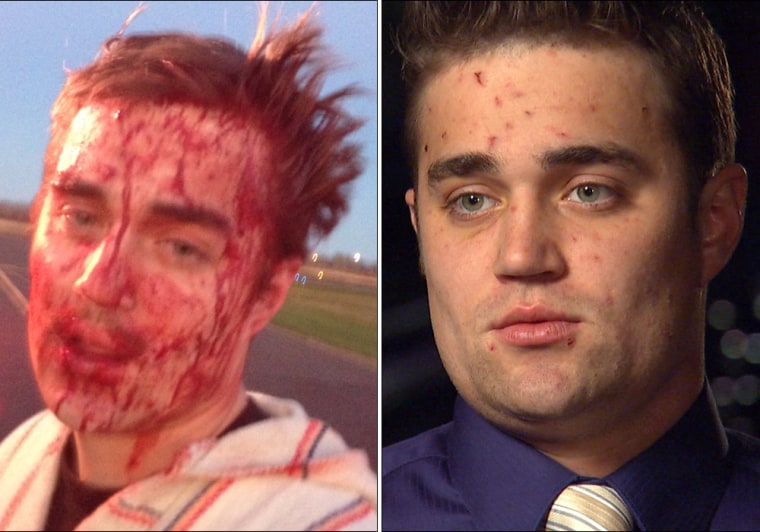
The pilot who escaped a skydiving plane collision by ditching his burning, crippled aircraft with an emergency parachute has a memento of the ordeal — a selfie he took right after his hard landing.
The photo shows Matt Fandler's face covered in blood from the shards of glass that flew at him when the Cessna's windshield shattered on impact.
Unseen in the picture are the cuts on his hands that took 25 stitches to repair, the bruises on his body or any emotional scars from the death-defying plunge after a midair accident at about 12,000 feet.
"I didn't have a mirror or anything, so I asked the police officer if he wanted to take a photo of me," Fandler, 23, told NBC News' Matt Lauer in an exclusive Dateline interview airing Friday at 8 p.m. A portion will also air earlier on TODAY at 7:30 a.m.
"He gave me a really weird look, so I decided to take it myself."
And it's a good thing he has the photographic evidence. Because as Fandler himself said, "If you would have told me I'd done what I did, I probably wouldn't believe it."
Last Saturday, Fandler was at the controls of one of two single-engine planes that were flying over Superior, Wisc., for a highly choreographed sunset jump by nine skydivers.
Fandler had done some skydiving himself — two freefalls with an instructor — and he was wearing an emergency parachute just to be on the safe side.
The flight had gone exactly as planned until the two planes, with Fandler's in the lead, reached 12,000 feet. Some of the thrill-seekers were on the exterior step, and Fandler was about to radio "jumpers away" to the other Cessna when, as he put it, "everything happened."
"And all of a sudden I hear this loud bang," he said. "I didn't see anything...I just heard a bang and the windshield immediately shattered."
Fandler's plane and the chase plane had smacked together, knocking some parachutists into the air and forcing the rest to jump for their lives — a terrifying turn of events that was captured on video by the divers' helmet cameras.
The crash had torn off the wing of Fandler's plane, and a fireball erupted as the gas tank blew.
Fandler, who had 400 hours of flying time under his belt, couldn't see that but he knew the situation was dire as the plane immediately began "an uncontrolled descent."
"I was staring straight ahead. And the first thing I remember thinking is that I need to regain control of this airplane," he recalled. "And I immediately pulled the yoke back to my chest and pulled it back as far as I possibly could. And there was no reaction from the airplane.
"I began to pick up more and more airspeed. And I realize that I have no control of this aircraft. And probably thought it was in my best interest to not be in this aircraft."
Fandler took his lap belt off, looked to the right and saw that the door to the plane was gone with the wing. He reached out with his right hand to hold onto the frame and "just jumped head first."
As he plunged through the sky, he got a glimpse of what he had left behind: the fuselage of the Cessna, one wing missing, hurtling toward the earth.
One of the skydivers, Daniel Chandler, was also looking at the plane. Not knowing whether Fandler had escaped, he wondered if he could somehow rescue him and attempted an acceleration maneuver in the hope of catching up to the out-of-control aircraft.
"It went somewhere from, like, 200 miles an hour to 300 miles an hour in just a split second," Chandler said. "And it was gone and there was absolutely nothing I could do. I had to accept that there was nothing I could do."
Fortunately, Fandler was out of the plane, but his fate remained uncertain. He'd never done a solo skydive and now he had to remember and use everything he'd learned in the previous two jumps.
He got himself into the proper arched position for a freefall and withstood the temptation to open the chute immediately, waiting until he was at the recommended 4,000 to 5,000 feet.
He was aiming for a flat area near the airport and ended up just 50 feet from the runway. It was a "decently hard" landing, and Fandler somersaulted to a stop and then stayed flat on the ground to get all the air out of his chute so he would not be dragged by a gust of wind.
He saw the other pilot, Blake Wedan, land his Cessna, having heroically regained control of it after the collision. And, one by one, he saw the skydivers on the ground, shaken but unhurt.
"It's a miracle after a miracle after a miracle after a miracle," said one of them, Lanaya Bonogofksy. "You're excited for one miracle. We got 11-plus."
She and the other eight all say they plan to go skydiving again, with no concern that maybe they've used up their ration for miracles.
"You can worry about that but then you're not going to be able to live your life," Bonogofksy said.
Fandler also plans to get back in the air, with the goal of one day flying bigger and faster planes.
"I really feel confident in my ability to be safe as a pilot. And I know what I can control. And I know what I cannot control," he said.
Related: